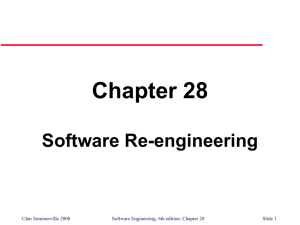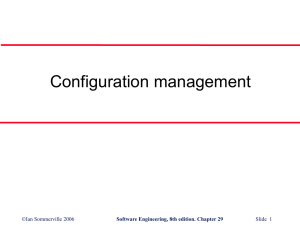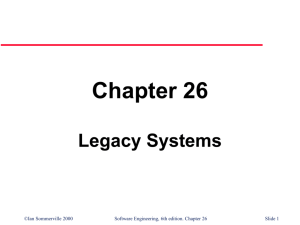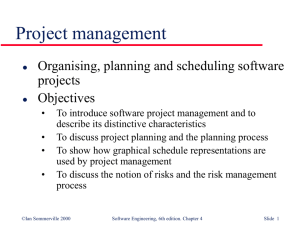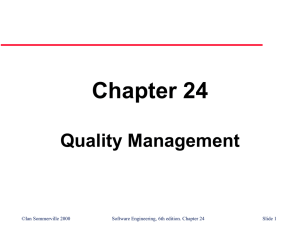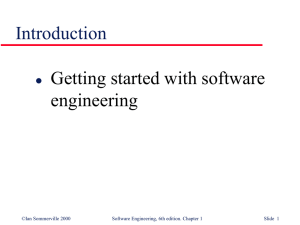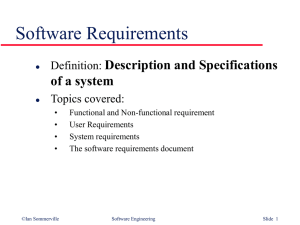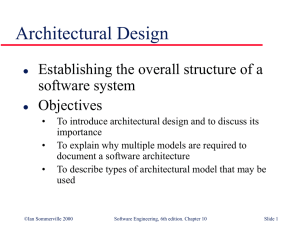Defect testing - Center for Software Engineering
advertisement
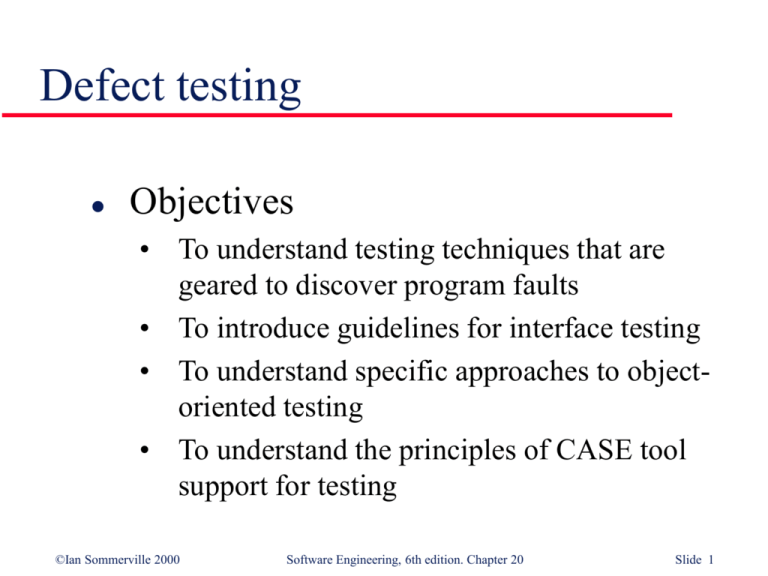
Defect testing Objectives • To understand testing techniques that are geared to discover program faults • To introduce guidelines for interface testing • To understand specific approaches to objectoriented testing • To understand the principles of CASE tool support for testing ©Ian Sommerville 2000 Software Engineering, 6th edition. Chapter 20 Slide 1 The testing process Component testing • • • Testing of individual program components Usually the responsibility of the component developer Tests are derived from the developer’s experience Integration testing • • • Testing of groups of components integrated to create a system or sub-system The responsibility of an independent testing team Tests are based on a system specification ©Ian Sommerville 2000 Software Engineering, 6th edition. Chapter 20 Slide 2 Defect testing The goal of defect testing is to discover defects in programs A successful defect test is a test which causes a program to behave in an anomalous way Tests show the presence, not the absence of defects Test data – Inputs which have been devised to test the system Test cases – Test data and the predicted outputs if the system operates according to its specification ©Ian Sommerville 2000 Software Engineering, 6th edition. Chapter 20 Slide 3 Testing priorities Only exhaustive testing can show a program is free from defects • However, exhaustive testing is impossible Testing old capabilities is more important than testing new capabilities Testing typical situations is more important than boundary value cases • But – boundary value cases should not be ignored! ©Ian Sommerville 2000 Software Engineering, 6th edition. Chapter 20 Slide 4 Black-box testing An approach to testing where the program is considered as a ‘black-box’ • Nothing is known about the system structure The program test cases are based on the system specification Test planning can begin early in the software process Acceptance testing is an example of black-box testing ©Ian Sommerville 2000 Software Engineering, 6th edition. Chapter 20 Slide 5 Black-box testing Input test data I Inputs causing anomalous behaviour e System Output test results ©Ian Sommerville 2000 Oe Outputs which reveal the presence of defects Software Engineering, 6th edition. Chapter 20 Slide 6 Equivalence partitioning Input data and output results often fall into different classes where all members of a class are related Each of these classes is an equivalence partition where the program behaves in an equivalent way for each class member A limited number of representative test cases should be chosen from each partition ©Ian Sommerville 2000 Software Engineering, 6th edition. Chapter 20 Slide 7 Equivalence partitioning Invalid inputs Valid inputs System Outputs ©Ian Sommerville 2000 Software Engineering, 6th edition. Chapter 20 Slide 8 Structural testing Sometime called white-box testing Derivation of test cases according to program structure Objective is to exercise (“cover”) certain aspect of the program • • Statement coverage Branch coverage » Condition coverage looks at every subexpression in a branch • Path coverage Leverages a program flow graph • Nodes represent program decisions and arcs represent the flow of control ©Ian Sommerville 2000 Software Engineering, 6th edition. Chapter 20 Slide 9 Path Coverage Objective: ensure the set of test cases executes each path through the program at least once Although all paths are executed, all combinations of paths are not executed Disadvantages • The number of paths is exponential to the number of branches • Adding one additional branch could double the number of paths to test • Many paths are impossible to exercise due to the relationships of data ©Ian Sommerville 2000 Software Engineering, 6th edition. Chapter 20 Slide 10 Example: Binary Search Flow Graph 1 bottom > top while bottom <= top • • • • 2 3 if (elemArray [mid] == key 4 8 5 (if (elemArray [mid]< key 6 9 7 Independent Paths 1, 2, 3, 8, 9 1, 2, 3, 4, 6, 7, 2 1, 2, 3, 4, 5, 7, 2 1, 2, 3, 4, 6, 7, 2, 8, 9 Test cases should be derived so that all of these paths are executed Integration testing Tests complete systems or subsystems composed of integrated components Integration testing should be black-box testing with tests derived from the specification Main difficulty is localising errors Incremental integration testing reduces this problem • • • Integrate A and B - test Integrate AB and C - test Integrate ABC and D - test ©Ian Sommerville 2000 Software Engineering, 6th edition. Chapter 20 Slide 12 Approaches to integration testing Top-down testing • Bottom-up testing • Start with high-level system and integrate from the top-down replacing individual components by stubs where appropriate Integrate individual components in levels until the complete system is created In practice, most integration involves a combination of these strategies ©Ian Sommerville 2000 Software Engineering, 6th edition. Chapter 20 Slide 13 Interface testing Takes place when modules or sub-systems are integrated to create larger systems Objectives are to detect faults due to interface errors or invalid assumptions about interfaces Particularly important for objectoriented development as objects are defined by their interfaces ©Ian Sommerville 2000 Test cases A Software Engineering, 6th edition. Chapter 20 B C Slide 14 Interface Errors Interface misuse • A calling component calls another component and makes an error in its use of its interface » e.g. parameters in the wrong order Interface misunderstanding • A calling component embeds assumptions about the behaviour of the called component that are incorrect Timing errors • The called and the calling component operate at different speeds and out-of-date information is accessed ©Ian Sommerville 2000 Software Engineering, 6th edition. Chapter 20 Slide 15 Interface testing guidelines Design tests so that parameters to a called procedure are at the extreme ends of their ranges Always test pointer parameters with null pointers Design tests that cause the component to fail Use stress testing in message passing systems In shared memory systems, vary the order in which components are activated ©Ian Sommerville 2000 Software Engineering, 6th edition. Chapter 20 Slide 16 Stress Testing Exercises the system beyond its maximum design load • Stressing the system tests its failure behavior • • Stressing the system often causes defects to come to light Systems should not fail catastrophically Stress testing checks for unacceptable loss of service or data Particularly relevant to distributed systems • Severe degradation as a network becomes overloaded ©Ian Sommerville 2000 Software Engineering, 6th edition. Chapter 20 Slide 17 Object-Oriented Testing The components to be tested are object classes that are instantiated as objects Larger grain than individual functions so approaches to white-box testing have to be extended No obvious ‘top’ to the system for top-down integration and testing Testing levels • • • • Testing operations associated with objects Testing object classes Testing clusters of cooperating objects Testing the complete OO system ©Ian Sommerville 2000 Software Engineering, 6th edition. Chapter 20 Slide 18 Object Class Testing Complete test coverage of a class involves • • • Inheritance makes it more difficult to design object class tests • Testing all operations associated with an object Setting and getting all object attributes Exercising the object in all possible states The information to be tested is not localised Class testing is complemented by scenario-based testing • • Identify scenarios from use-cases Supplement these with interaction diagrams that show the objects involved in the scenario ©Ian Sommerville 2000 Software Engineering, 6th edition. Chapter 20 Slide 19 A Testing Workbench Test data generator Specification Source code Test manager Test data Oracle Dynamic analyser Program being tested Test results Test predictions Execution report Simulator File comparator Report generator ©Ian Sommerville 2000 Software Engineering, 6th edition. Chapter 20 Test results report Slide 20 Key points Test parts of a system which are commonly used rather than those which are rarely executed Equivalence partitions are sets of test cases where the program should behave in an equivalent way Black-box testing is based on the system specification White-box testing is based on the system implementation ©Ian Sommerville 2000 Software Engineering, 6th edition. Chapter 20 Slide 21 Key points Test coverage measures ensure that desired aspects of the system’s implementation have been executed at least once Interface defects arise because of specification misreading, misunderstanding, errors or invalid timing assumptions To test object classes, test all operations, attributes and states ©Ian Sommerville 2000 Software Engineering, 6th edition. Chapter 20 Slide 22
